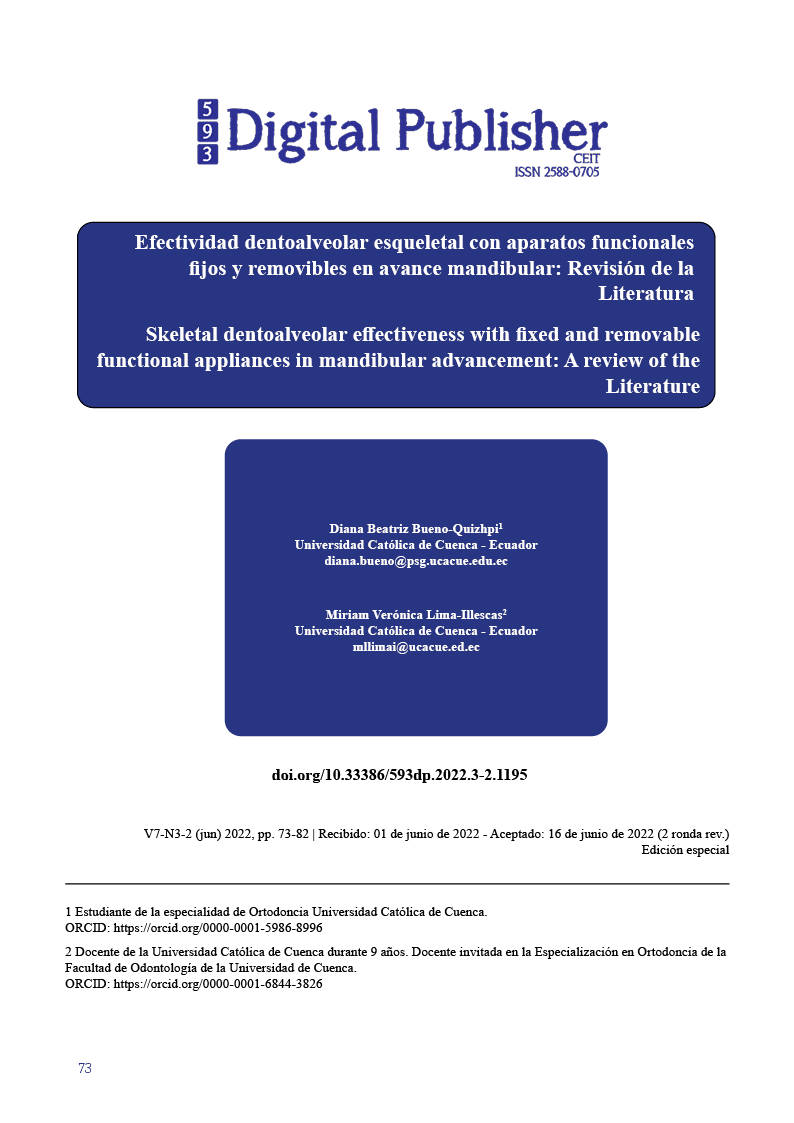Efectividad dentoalveolar esqueletal con aparatos funcionales fijos y removibles en avance man-dibular: Revisión de la Literatura
Contenido principal del artículo
Resumen
La efectividad de los aparatos funcionales ha sido estudiada durante los últimos años, para la corrección de la maloclusión clase II por retrognatismo mandibular se utilizan aparatos funcionales fijos y removibles, ya que establecen el equilibrio muscular, eliminan la disfunción oral y permiten una longitud adecuada de la mandíbula, y a la vez la corrección de la estética facial, este tipo de maloclusión es una condición frecuente, padece más del 50% de la población, es autosómico dominante, cuyo tratamiento se realiza durante el pico de crecimiento puberal. El objetivo es analizar las publicaciones existentes sobre la efectividad de los aparatos funcionales fijos y removibles en el retrognatismo mandibular. Se analizaron artículos que fueron obtenidos de tres bases de datos digitales: PubMed, World Wide Science, BVS. La literatura evaluó la efectividad dentoalveolar y esqueletal de los aparatos funcionales fijos y removibles en avance mandibular, independiente de la aparatología utilizada y en este estudio de revisión se ha buscado dilucidar si los aparatos funcionales consiguen estimular el crecimiento mandibular. Los aparatos funcionales removibles producen mayores cambios esqueléticos y menores efectos dentoalveolares tales como: aumento de la longitud mandibular y avance del mentón, en comparación a los fijos existe cambios esqueléticos, pero en menor proporción y mayores cambios dentoalveolares tales como proinclinación y protrusión de los incisivos inferiores.
Descargas
Detalles del artículo

Esta obra está bajo una licencia internacional Creative Commons Atribución-NoComercial-CompartirIgual 4.0.
1. Derechos de autor
Las obras que se publican en 593 Digital Publisher CEIT están sujetas a los siguientes términos:
1.1. 593 Digital Publisher CEIT, conserva los derechos patrimoniales (copyright) de las obras publicadas, favorece y permite la reutilización de las mismas bajo la licencia Licencia Creative Commons 4.0 de Reconocimiento-NoComercial-CompartirIgual 4.0, por lo cual se pueden copiar, usar, difundir, transmitir y exponer públicamente, siempre que:
1.1.a. Se cite la autoría y fuente original de su publicación (revista, editorial, URL).
1.1.b. No se usen para fines comerciales u onerosos.
1.1.c. Se mencione la existencia y especificaciones de esta licencia de uso.
Citas
Al-Jewair, T. S. (2015). Meta-analysis on the mandibular dimensions effects of the MARA appliance in patients with Class II malocclusions. Angle Orthodontist, 85(4), 706–714. https://doi.org/10.2319/052814-378.1
Alali, O. H. (2014). A prospective controlled evaluation of Class II division 1 malocclusions treated with fixed lingual mandibular growth modificator. Angle Orthodontist, 84(3), 527–533. https://doi.org/10.2319/070913-500.1
Amuk, N. G., Baysal, A., Coskun, R., & Kurt, G. (2019). Effectiveness of incremental vs maximum bite advancement during Herbst appliance therapy in late adolescent and young adult patients. American Journal of Orthodontics and Dentofacial Orthopedics, 155(1), 48–56. https://doi.org/10.1016/j.ajodo.2018.02.014
Angelieri, F., Franchi, L., Cevidanes, L. H. S., Scanavini, M. A., & Mcnamara, J. A. (2014). Long-term treatment effects of the FR-2 appliance: A prospective evalution 7 years post-treatment. European Journal of Orthodontics, 36(2), 192–199. https://doi.org/10.1093/ejo/cjt026
Aras, I., Pasaoglu, A., Olmez, S., Unal, I., & Aras, A. (2016). Upper airway changes following single-step or stepwise advancement using the Functional Mandibular Advancer. Journal of Orofacial Orthopedics, 77(6), 454–462. https://doi.org/10.1007/s00056-016-0062-0
Arora, V., Sharma, R., & Chowdhary, S. (2018). Comparative evaluation of treatment effects between two fixed functional appliances for correction of Class II malocclusion: A single-center, randomized controlled trial. Angle Orthodontist, 88(3), 259–266. https://doi.org/10.2319/071717-476.1
Baysal, Asl, & Uysal, T. (2013). Soft tissue effects of twin block and herbst appliances in patients with class ii division 1 mandibular retrognathy. European Journal of Orthodontics, 35(1), 71–81. https://doi.org/10.1093/ejo/cjq187
Baysal, Asli, & Uysal, T. (2014). Dentoskeletal effects of Twin Block and Herbst appliances in patients with Class II division 1 mandibular retrognathy. European Journal of Orthodontics, 36(2), 164–172. https://doi.org/10.1093/ejo/cjt013
Burhan, A. S., & Nawaya, F. R. (2015). Dentoskeletal effects of the Bite-Jumping Appliance and the Twin-Block Appliance in the treatment of skeletal Class II malocclusion: a randomized controlled trial. European Journal of Orthodontics, 37(3), 330–337. https://doi.org/10.1093/ejo/cju052
D’Antò, V., Bucci, R., Franchi, L., Rongo, R., Michelotti, A., & Martina, R. (2015). Class II functional orthopaedic treatment: A systematic review of systematic reviews. Journal of Oral Rehabilitation, 42(8), 624–642. https://doi.org/10.1111/joor.12295
Ivorra-Carbonell, L., Montiel-Company, J. M., Almerich-Silla, J. M., Paredes-Gallardo, V., & Bellot-Arcís, C. (2016). Impact of functional mandibular advancement appliances on the temporomandibular joint - A systematic review. Medicina Oral Patologia Oral y Cirugia Bucal, 21(5), e565–e572. https://doi.org/10.4317/medoral.21180
Knösel, M., Espinoza-Espinoza, G. E., Sandoval-Vidal, P., & Zaror, C. (2020). Angle class II correction: stepwise mandibular advancement or bite jumping?: A systematic review and meta-analysis of skeletal, dental and condylar effects. Journal of Orofacial Orthopedics, 81(4), 286–300. https://doi.org/10.1007/s00056-020-00226-6
Martina, R., Cioffi, I., Galeotti, A., Tagliaferri, R., Cimino, R., Michelotti, A., Valletta, R., Farella, M., & Paduano, S. (2013). Efficacy of the Sander bite-jumping appliance in growing patients with mandibular retrusion: A randomized controlled trial. Orthodontics and Craniofacial Research, 16(2), 116–126. https://doi.org/10.1111/ocr.12013
Moro, A., Mattos, C. F. P., Borges, S. W., Flores-Mir, C., & Topolski, F. (2020). Stability of Class II corrections with removable and fixed functional appliances: A literature review. Journal of the World Federation of Orthodontists, 9(2), 56–67. https://doi.org/10.1016/j.ejwf.2020.04.003
Phelan, A., Tarraf, N. E., Taylor, P., Hönscheid, R., Drescher, D., Baccetti, T., & Darendeliler, M. A. (2012). Skeletal and dental outcomes of a new magnetic functional appliance, the Sydney Magnoglide, in Class II correction. American Journal of Orthodontics and Dentofacial Orthopedics, 141(6), 759–772. https://doi.org/10.1016/j.ajodo.2012.01.014
Santamaría-Villegas, A., Manrique-Hernandez, R., Alvarez-Varela, E., & Restrepo-Serna, C. (2017). Effect of removable functional appliances on mandibular length in patients with class II with retrognathism: Systematic review and meta-analysis. BMC Oral Health, 17(1), 1–9. https://doi.org/10.1186/s12903-017-0339-8
Santana, L. G., Avelar, K., Flores-Mir, C., & Marques, L. S. (2020). Incremental or maximal mandibular advancement in the treatment of class II malocclusion through functional appliances: A systematic review with meta-analysis. Orthodontics and Craniofacial Research, 23(4), 371–384. https://doi.org/10.1111/ocr.12388
Schulz, S., Koos, B., Duske, K., & Stahl, F. (2016). Skelettale Therapieeffekte des Funktionsreglers Typ II bei Klasse-II/1-Patienten: Evaluierung mittels Kephalometrie und Tensoranalyse. Journal of Orofacial Orthopedics, 77(6), 420–431. https://doi.org/10.1007/s00056-016-0050-4
Yaqoob, O., Dibiase, A. T., Fleming, P. S., & Cobourne, M. T. (2012). Use of the Clark Twin Block functional appliance with and without an upper labial bow: A randomized controlled trial. Angle Orthodontist, 82(2), 363–369. https://doi.org/10.2319/041411-268.1
Zymperdikas, V. F., Koretsi, V., Papageorgiou, S. N., & Papadopoulos, M. A. (2016). Treatment effects of fixed functional appliances in patients with Class II malocclusion: A systematic review and meta-analysis. European Journal of Orthodontics, 38(2), 113–126. https://doi.org/10.1093/ejo/cjv034



